Central Registration for MQTT Client
The Central Registration method allows you to complete the MQTT Client installation and register it with Configuration Hub either soon after installation or at a later time. During MQTT Client installation, you have the option to skip providing the Configuration Hub and Proficy Authentication server details. After a successful installation, use the Node Manager Configuration desktop shortcut (that is, Node Manager utility) to configure the Node Manager and update the MQTT Client with Proficy Authentication.
Procedure
- From the ISO folder, double-click the .iso file or select Mount from the context menu.
-
Double-click the Setup.bat file, which will launch the Proficy
installer.
For example, here with what the MQTT Client option that shows up on the iFIX install:
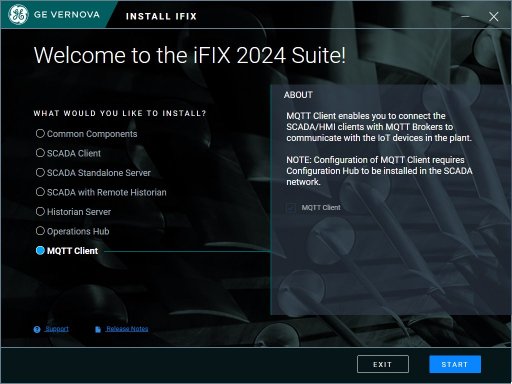 The welcome screen for the MQTT Client appears.
The welcome screen for the MQTT Client appears. - Select MQTT Client, and then select START.
- Select ACCEPT to proceed with the License Agreement.
-
Select NEXT to install the MQTT Client product in the
default location <Install_location>\Proficy or click
 to modify the install location.
to modify the install location.
-
In the Registration with Configuration Hub screen, select
Skip this step to continue with installation and register later with
utility check box, and then select NEXT.
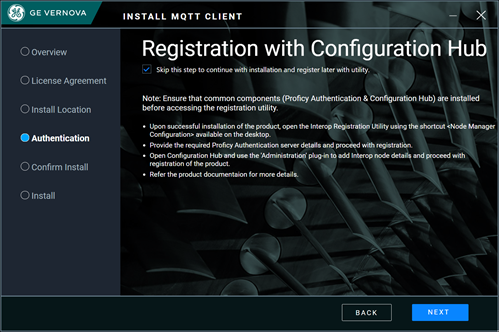 Important: To proceed with the Central Registration process, you must skip providing Configuration Hub and Proficy Authentication server details.
Important: To proceed with the Central Registration process, you must skip providing Configuration Hub and Proficy Authentication server details. -
Select START in the Confirm Install
screen to start the product installation.
The MQTT Client product is installed in the <install location\Program Files\Proficy>.Note: During the MQTT Client installation, the License Client will also be installed silently.
- Select CLOSE.
- After successfully installing the MQTT Client product, you must restart your machine for the proper functioning of the MQTT Client software. Select REBOOT NOW to restart your machine.
-
After you restart the machine, ensure that Configuration Hub and Proficy
Authentication are installed with version 2024 or upgraded to version 2024 or higher,
as applicable on your machine.
Note: You can install the Common components, which include Configuration Hub and Proficy Authentication, directly from the welcome screen of the MQTT Client (2024 and above), iFIX (2023 and above), or CIMPLICITY (2024 and above) Proficy installers.
- Ensure that you set up Proficy Authentication in Configuration Hub. Refer to Set up Proficy Authentication for more details.
-
Double click the
 Node Manager Configuration desktop shortcut (Node Manager
utility).
The Node Manager Configuration window appears.
Node Manager Configuration desktop shortcut (Node Manager
utility).
The Node Manager Configuration window appears.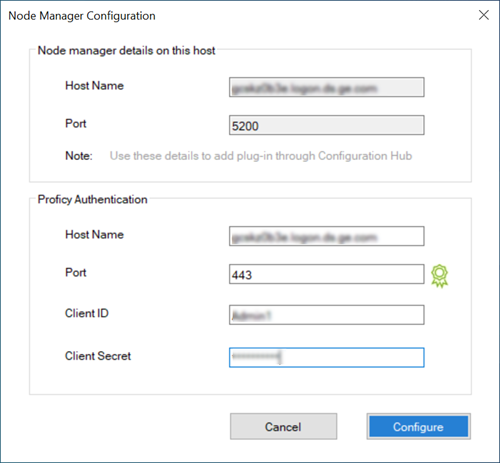
-
Configure the Node Manager in the following sections:
- Proficy Authentication
- Host Name: The name of the Proficy Authentication server to which you want to update the product(s) with Proficy Authentication, in the <Fully Qualified Domain Name> format.
- Port: The port number of the Proficy Authentication server.
- Client Id: The client ID of the Proficy Authentication server, provided during the Proficy Authentication installation.
- Client Secret: The client secret of the Proficy Authentication server, provided during the Proficy Authentication installation.
Note: If the root certificate of the Proficy Authentication server is not trusted, then click not trusted , the Certificate Details
page appears. Select Trust to trust the root
certificate.
, the Certificate Details
page appears. Select Trust to trust the root
certificate.The root certificate is trusted
 .
.
- Node manager details on this host
- Host Name: The name of the node server where the product is installed, in the <Fully Qualified Domain Name> format. This field is automatically populated and disabled.
- Port: The node manager port number where the product is installed. The port number field is disabled.
Note: Ensure that you enter the same host details to integrate the MQTT Client plugin in Node Manager within Configuration Hub and proceed with the registration of the MQTT Client in Configuration Hub.
- Proficy Authentication
-
Select Configure.
The following message appears.
Successfully updated Proficy authentication for Products <MQTT Client installed>.
-
Double-click the
 Configuration Hub desktop shortcut.
Configuration Hub desktop shortcut.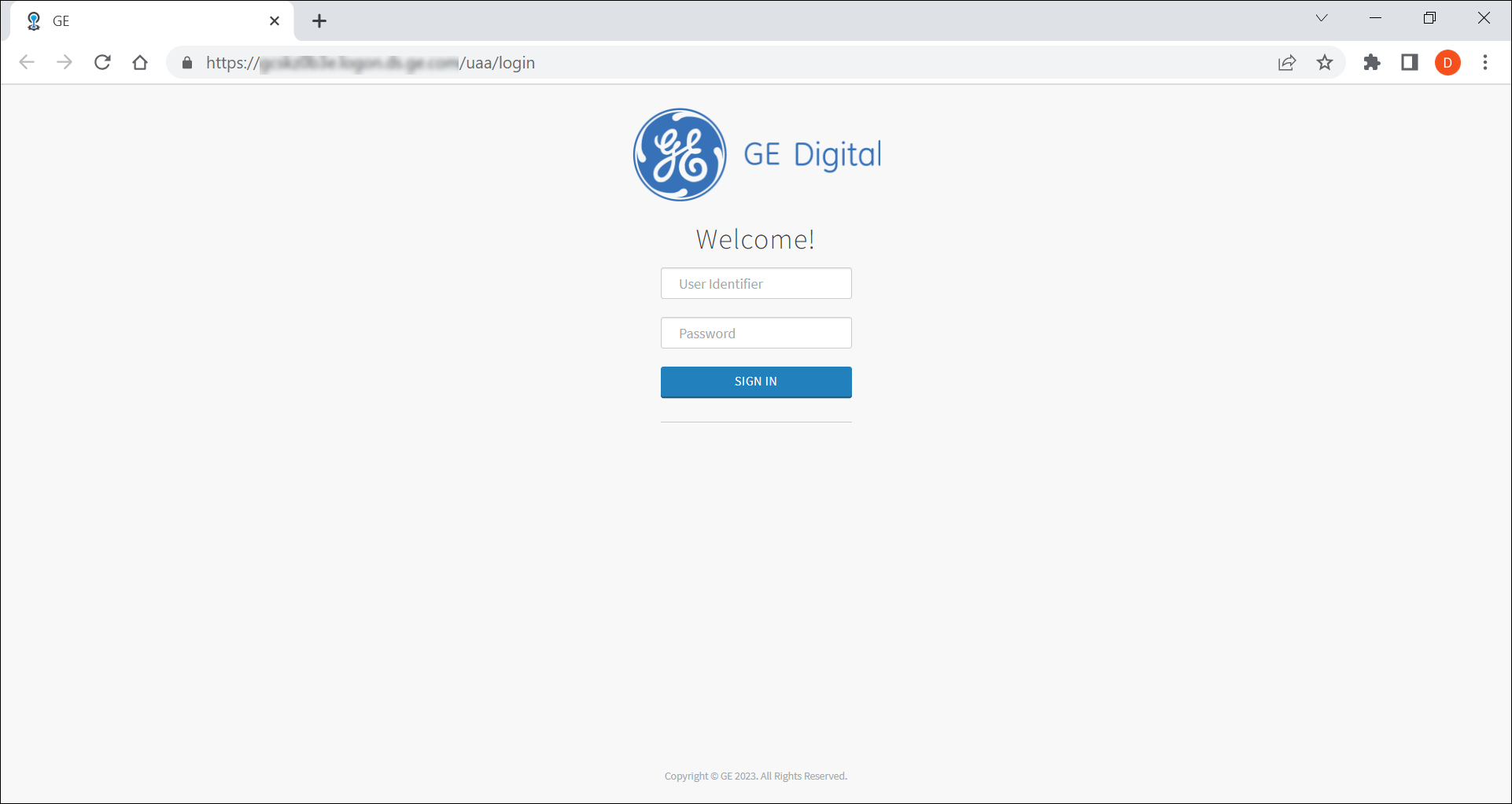
-
Enter the following credentials, and then select SIGN
IN.
- User Identifier: The default user id for first time users, that is, ch_admin.
- Password: The password you entered in the Client Secret field in the Proficy Authentication section of the Node Manager Configuration window. Refer Step 13.
The Configuration Hub user interface appears.Note: In the NAVIGATION panel, in Proficy Authentication, include the groups as required. Only the administrator with admin rights in Security-Proficy Authentication can provide user permissions to the groups. Refer to the Proficy Authentication help documentation for more details on managing Groups and Users to have access permissions. -
In the NAVIGATION panel, select
 Administration plugin.
The Node Manager and License Server panels will appear.
Administration plugin.
The Node Manager and License Server panels will appear. -
Select Node Manager.
The Node Manager-Administration panel appears displaying the Configuration Hub and Proficy Authentication product details.
-
Select
 to add the Node Manager.
to add the Node Manager.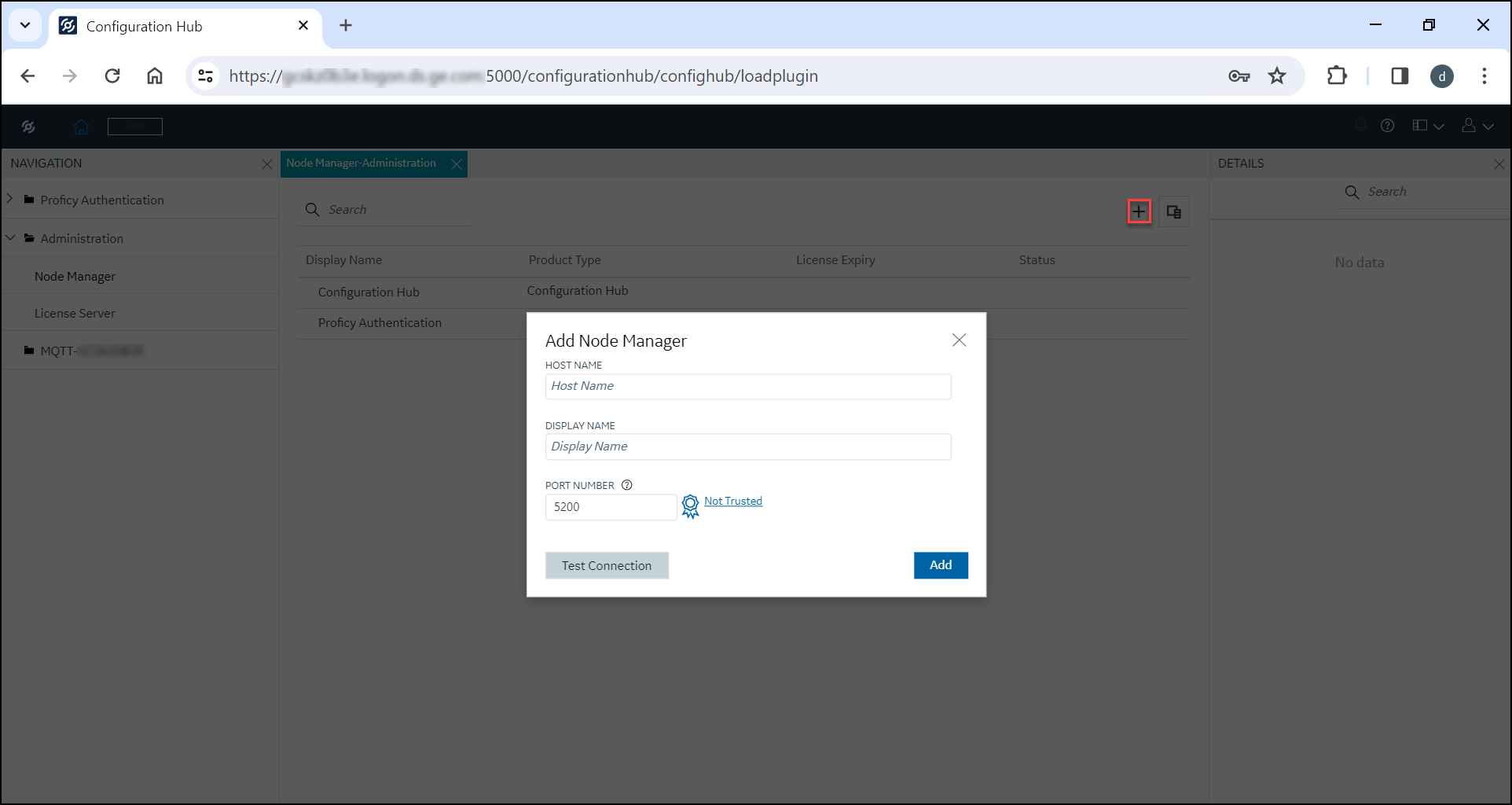 The Add Node Manager window appears. Enter the following details:
The Add Node Manager window appears. Enter the following details:- HOST NAME: The name of the node server where the MQTT Client is installed. In the <Fully Qualified Domain Name> format.
- DISPLAY NAME: The display name is automatically populated, reflecting the host name field. You can choose to edit the display name as needed.
- PORT NUMBER: The node manager port number where the MQTT Client is
installed.Note: The HOST NAME and PORT NUMBER details, as populated in the Node Manager Configuration window under the Node Manager details on this host section, must match the same details. Refer to Step 13.
Note: If the root certificate of the Node Manager is not trusted, then click not trusted , the
Certificate Details page appears. Select
Trust to trust the root certificate.
, the
Certificate Details page appears. Select
Trust to trust the root certificate.The root certificate is trusted
 .
. -
Select Add.
The Node Manager added successfully message appears.
-
Select the Node Manager row.
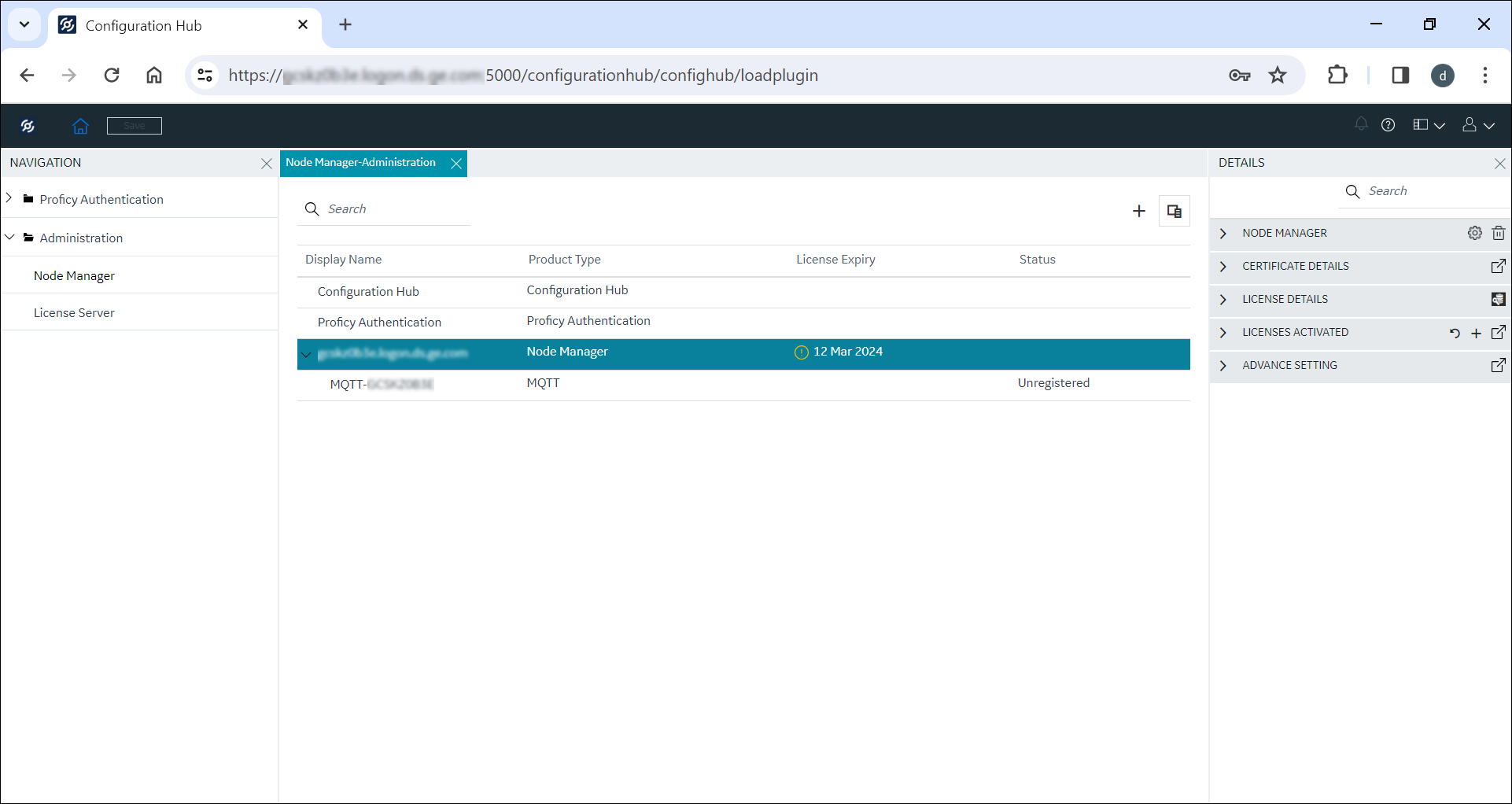 You can perform the following actions in the Node Manager section within the DETAILS panel:
You can perform the following actions in the Node Manager section within the DETAILS panel:- Select
 of the NODE MANAGER and, if required,
modify the Display Name field to update the Node Manager display name.Note: You can modify the Node Manager display name only after adding the Node Manager.
of the NODE MANAGER and, if required,
modify the Display Name field to update the Node Manager display name.Note: You can modify the Node Manager display name only after adding the Node Manager.-
Select the Manage
 button.
button.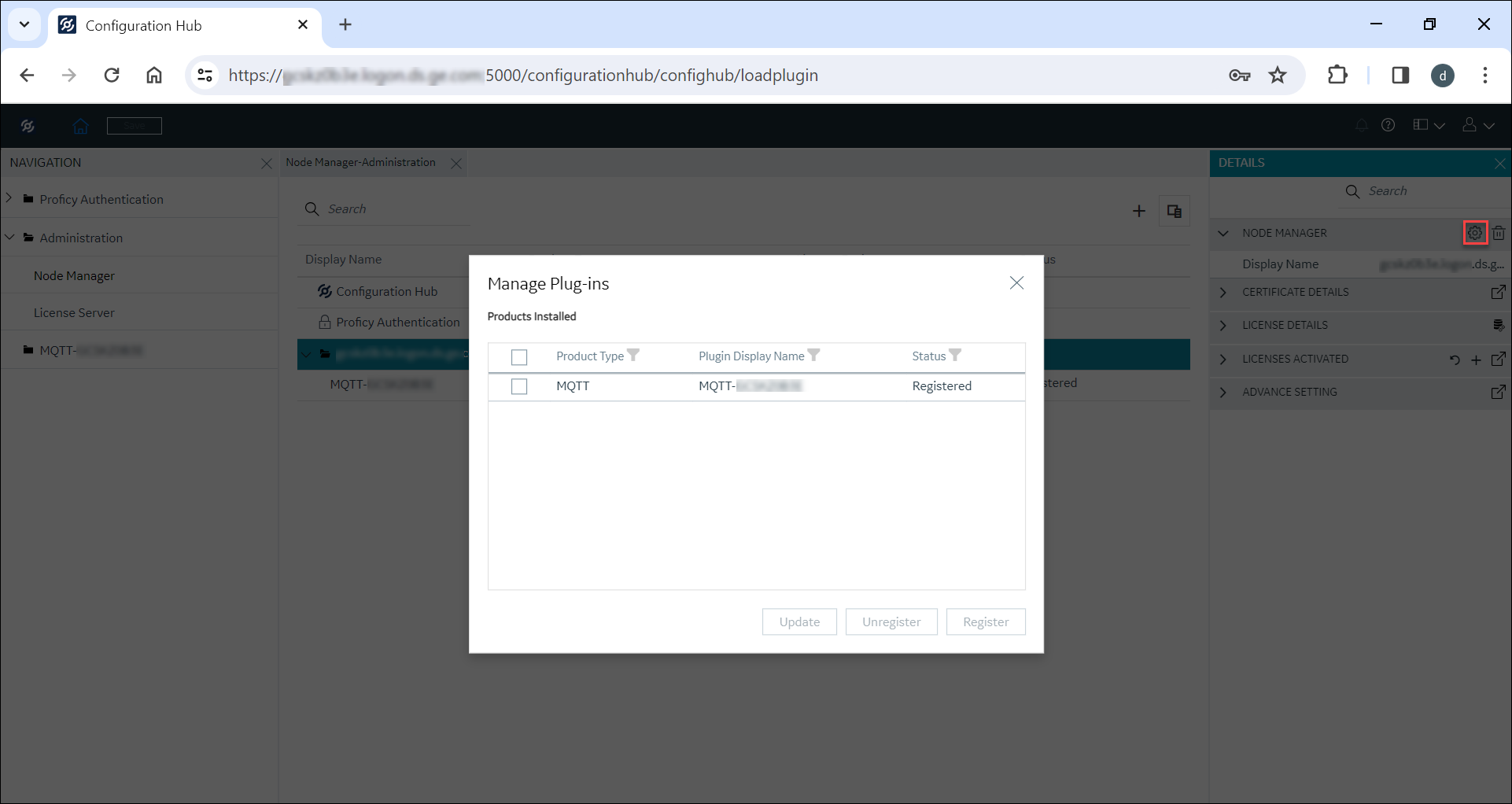
The Manage Plug-ins window appears displaying the Products Installed. Select the checkbox against the MQTT Client, and then select Register to register the MQTT Client product plugin to Configuration Hub, or Unregister to unregister the MQTT Client product plugin from Configuration Hub, or Update to modify the display name of the MQTT Client product plugin as required. Only after registering a product, the MQTT Client product plugin will appear in the NAVIGATION panel.
- Select the Delete
 button.
button.The Delete Node Manager window appears. If you select Continue, the Node Manager removes the MQTT Client product from the NAVIGATION panel. You will need to add the Node Manager again to operate the MQTT Client product plugin. Additionally, you can select the checkbox if you want to unregister the MQTT Client plugin on the selected node from Configuration Hub.
Note: You can also right-click on the Node Manager panel row and select Manage or Delete as needed to perform actions similar to those in the Node Manager section within the DETAILS panel.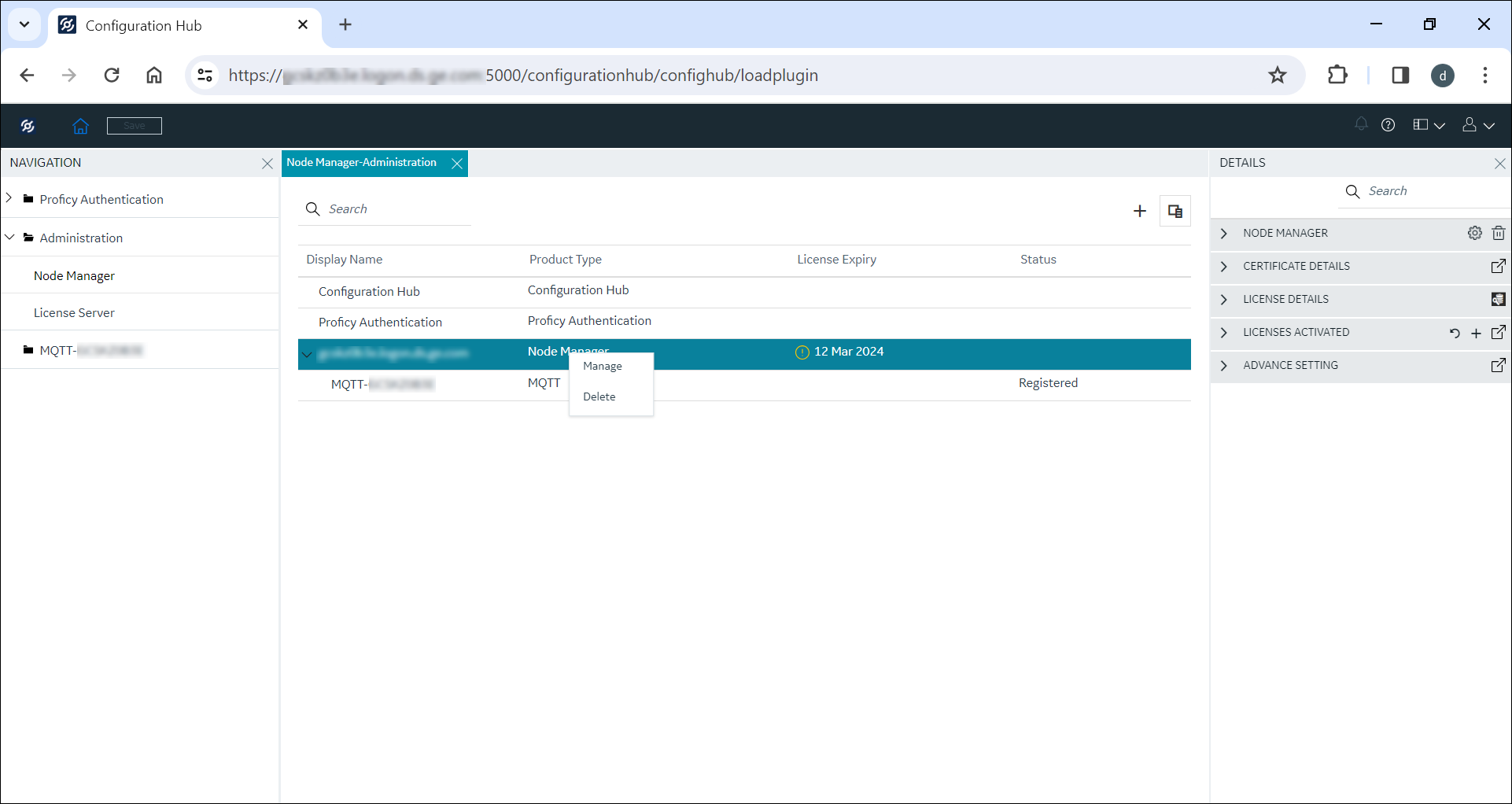
-
- Select
-
Select
 of the Node Manager row from the Node manager
panel.
The list of Proficy product(s) installed on the node appears. Select the MQTT Client product row, the DETAILS panel display the MQTT Client product details. You can perform the following actions:
of the Node Manager row from the Node manager
panel.
The list of Proficy product(s) installed on the node appears. Select the MQTT Client product row, the DETAILS panel display the MQTT Client product details. You can perform the following actions:- Select
 of the PLUG-IN and, if required, modify the
Display Name field to update the MQTT Client plugin display name.Note: You can modify the MQTT Client plugin display name only after registering MQTT Client with Configuration Hub.
of the PLUG-IN and, if required, modify the
Display Name field to update the MQTT Client plugin display name.Note: You can modify the MQTT Client plugin display name only after registering MQTT Client with Configuration Hub.- Select Register
 button.
button. The Register Plug-in window appears. The PLUGIN HOST, PRODUCT TYPE, and DISPLAY NAME fields are auto populated. Select Register to register MQTT Client with Configuration Hub.
The <MQTT Client> Registered Successfully message appears, and the MQTT Client product plugin is now listed in the NAVIGATION panel. - Select Unregister
 button.
button. The Unregister Plug-in window appears. If you select Continue to unregister MQTT Client, the MQTT Client plugin will be removed from the NAVIGATION panel. Also, any open panel belonging to this plugin will be closed, and changes to the MQTT Client plugin will not be saved.
Note: You can also right-click on the MQTT Client product row and select Register or Unregister as needed to perform actions similar to those in the PLUG-IN section within the DETAILS panel.If you select Register, the <MQTT Client> Registered Successfully message appears, and the MQTT Client product plugin is now listed in the NAVIGATION panel.
You can now enable your HMI/SCADA OPC UA clients to communicate with IoT devices and MQTT brokers by using MQTT Client.

- Select Register
- Select
-
If you are not licensed to use the MQTT Client, the MQTT Client will run in Demo
mode for two hours, after which the following message will be displayed in the
Configuration Hub user interface.
Demo license expired. Restart the MQTTClient service.
When you try to load the MQTT plugin connection, the following error message will be displayed.Service unavailable. Restart the MqttClient service.
Perform the following steps to start the MQTT Client Service:- Right-click the Windows Start menu, and then click Computer Management.
- Click Services and Applications and then, double-click
 Services.
Services. - Click GE MQTT Client Service and click Start to start the GE MQTT Client Service.
After starting the GE MQTT Client Service, when you select <MQTT plugin name> in Configuration Hub, the Connections-<MQTT plugin name> panel will display the Demo license expiry time.
Important: If you run the MQTT Client in Demo license mode, OPC UA write permissions are not supported. As a result, the OPC UA clients can only read the values of OPCUA tags but cannot write to or modify them.Refer to the OPC UA for MQTT Clients section for more information.